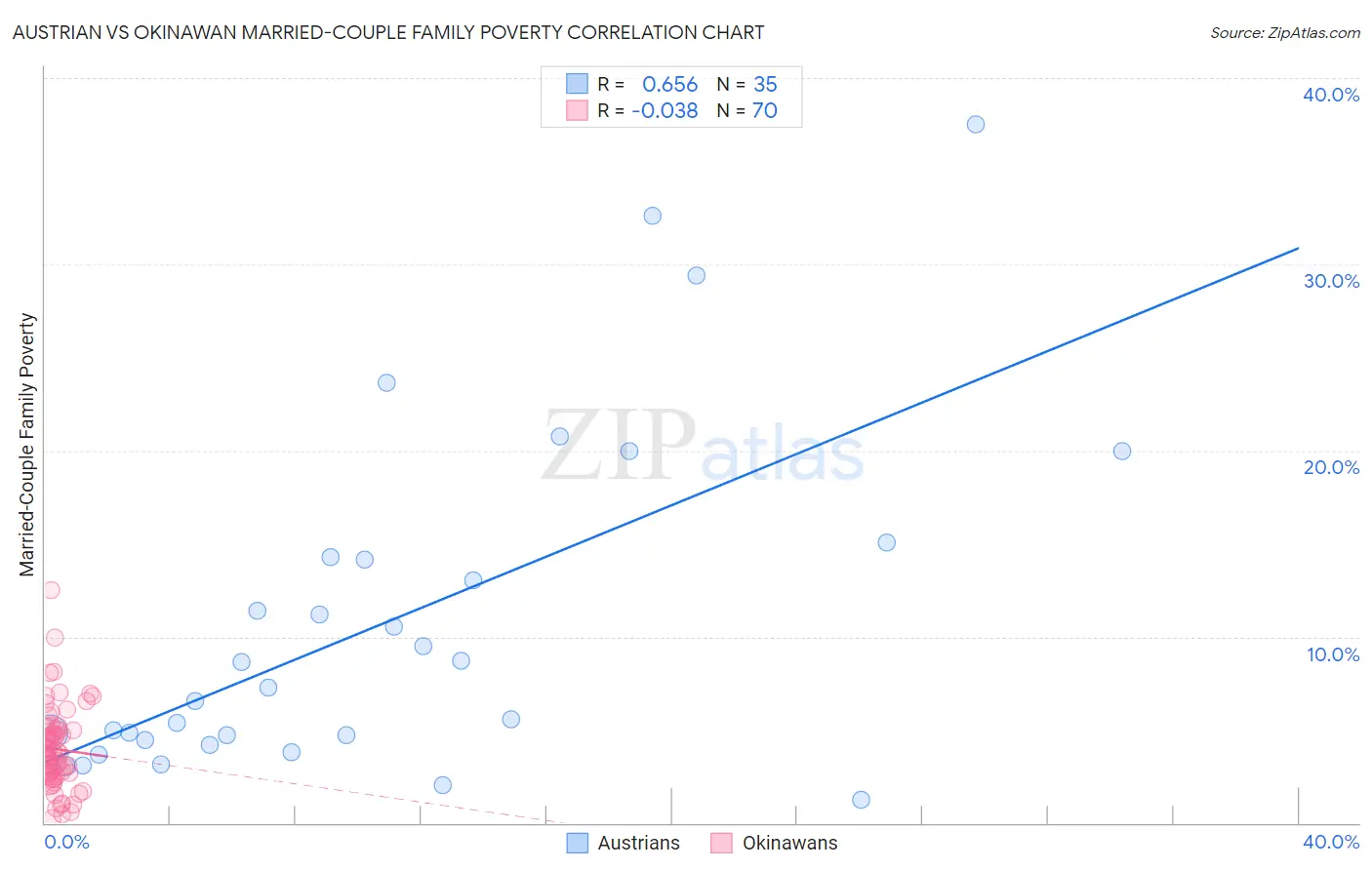Austrian vs Okinawan Married-Couple Family Poverty
COMPARE
Austrian
Okinawan
Married-Couple Family Poverty
Married-Couple Family Poverty Comparison
Austrians
Okinawans
4.3%
MARRIED-COUPLE FAMILY POVERTY
99.7/ 100
METRIC RATING
54th/ 347
METRIC RANK
4.4%
MARRIED-COUPLE FAMILY POVERTY
99.6/ 100
METRIC RATING
61st/ 347
METRIC RANK
Austrian vs Okinawan Married-Couple Family Poverty Correlation Chart
The statistical analysis conducted on geographies consisting of 445,465,391 people shows a significant positive correlation between the proportion of Austrians and poverty level among married-couple families in the United States with a correlation coefficient (R) of 0.656 and weighted average of 4.3%. Similarly, the statistical analysis conducted on geographies consisting of 73,604,889 people shows no correlation between the proportion of Okinawans and poverty level among married-couple families in the United States with a correlation coefficient (R) of -0.038 and weighted average of 4.4%, a difference of 1.0%.

Married-Couple Family Poverty Correlation Summary
| Measurement | Austrian | Okinawan |
| Minimum | 1.3% | 0.25% |
| Maximum | 37.5% | 12.5% |
| Range | 36.2% | 12.3% |
| Mean | 10.8% | 4.0% |
| Median | 7.2% | 3.7% |
| Interquartile 25% (IQ1) | 4.5% | 2.5% |
| Interquartile 75% (IQ3) | 14.3% | 5.0% |
| Interquartile Range (IQR) | 9.8% | 2.5% |
| Standard Deviation (Sample) | 9.1% | 2.2% |
| Standard Deviation (Population) | 9.0% | 2.2% |
Demographics Similar to Austrians and Okinawans by Married-Couple Family Poverty
In terms of married-couple family poverty, the demographic groups most similar to Austrians are French (4.3%, a difference of 0.020%), Immigrants from Zimbabwe (4.3%, a difference of 0.18%), Immigrants from Netherlands (4.3%, a difference of 0.18%), Welsh (4.3%, a difference of 0.26%), and Czechoslovakian (4.4%, a difference of 0.27%). Similarly, the demographic groups most similar to Okinawans are Immigrants from Australia (4.4%, a difference of 0.010%), Tlingit-Haida (4.4%, a difference of 0.11%), Immigrants from Sweden (4.4%, a difference of 0.18%), Immigrants from Sri Lanka (4.4%, a difference of 0.37%), and Czechoslovakian (4.4%, a difference of 0.73%).
| Demographics | Rating | Rank | Married-Couple Family Poverty |
| Immigrants | South Central Asia | 99.8 /100 | #47 | Exceptional 4.3% |
| Australians | 99.7 /100 | #48 | Exceptional 4.3% |
| Turks | 99.7 /100 | #49 | Exceptional 4.3% |
| Burmese | 99.7 /100 | #50 | Exceptional 4.3% |
| Immigrants | Lithuania | 99.7 /100 | #51 | Exceptional 4.3% |
| Russians | 99.7 /100 | #52 | Exceptional 4.3% |
| Welsh | 99.7 /100 | #53 | Exceptional 4.3% |
| Austrians | 99.7 /100 | #54 | Exceptional 4.3% |
| French | 99.7 /100 | #55 | Exceptional 4.3% |
| Immigrants | Zimbabwe | 99.7 /100 | #56 | Exceptional 4.3% |
| Immigrants | Netherlands | 99.7 /100 | #57 | Exceptional 4.3% |
| Czechoslovakians | 99.7 /100 | #58 | Exceptional 4.4% |
| Immigrants | Sweden | 99.6 /100 | #59 | Exceptional 4.4% |
| Tlingit-Haida | 99.6 /100 | #60 | Exceptional 4.4% |
| Okinawans | 99.6 /100 | #61 | Exceptional 4.4% |
| Immigrants | Australia | 99.6 /100 | #62 | Exceptional 4.4% |
| Immigrants | Sri Lanka | 99.6 /100 | #63 | Exceptional 4.4% |
| Immigrants | Bulgaria | 99.5 /100 | #64 | Exceptional 4.4% |
| Macedonians | 99.4 /100 | #65 | Exceptional 4.4% |
| Immigrants | Serbia | 99.4 /100 | #66 | Exceptional 4.4% |
| Immigrants | Canada | 99.4 /100 | #67 | Exceptional 4.4% |